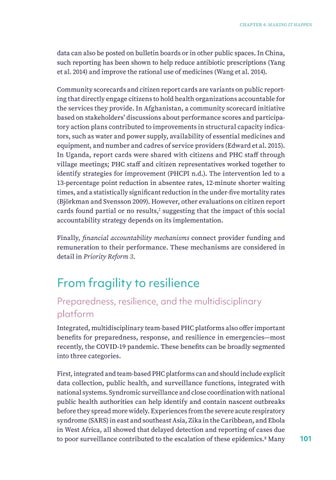CHAPTER 4: MAKING IT HAPPEN
data can also be posted on bulletin boards or in other public spaces. In China, such reporting has been shown to help reduce antibiotic prescriptions (Yang et al. 2014) and improve the rational use of medicines (Wang et al. 2014). Community scorecards and citizen report cards are variants on public reporting that directly engage citizens to hold health organizations accountable for the services they provide. In Afghanistan, a community scorecard initiative based on stakeholders’ discussions about performance scores and participatory action plans contributed to improvements in structural capacity indicators, such as water and power supply, availability of essential medicines and equipment, and number and cadres of service providers (Edward et al. 2015). In Uganda, report cards were shared with citizens and PHC staff through village meetings; PHC staff and citizen representatives worked together to identify strategies for improvement (PHCPI n.d.). The intervention led to a 13-percentage point reduction in absentee rates, 12-minute shorter waiting times, and a statistically significant reduction in the under-five mortality rates (Björkman and Svensson 2009). However, other evaluations on citizen report cards found partial or no results,7 suggesting that the impact of this social accountability strategy depends on its implementation. Finally, financial accountability mechanisms connect provider funding and remuneration to their performance. These mechanisms are considered in detail in Priority Reform 3.
From fragility to resilience Preparedness, resilience, and the multidisciplinary platform Integrated, multidisciplinary team-based PHC platforms also offer important benefits for preparedness, response, and resilience in emergencies—most recently, the COVID-19 pandemic. These benefits can be broadly segmented into three categories. First, integrated and team-based PHC platforms can and should include explicit data collection, public health, and surveillance functions, integrated with national systems. Syndromic surveillance and close coordination with national public health authorities can help identify and contain nascent outbreaks before they spread more widely. Experiences from the severe acute respiratory syndrome (SARS) in east and southeast Asia, Zika in the Caribbean, and Ebola in West Africa, all showed that delayed detection and reporting of cases due to poor surveillance contributed to the escalation of these epidemics.8 Many
101


